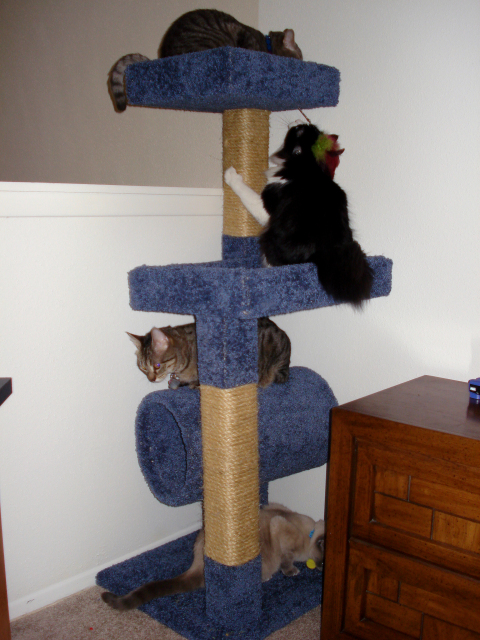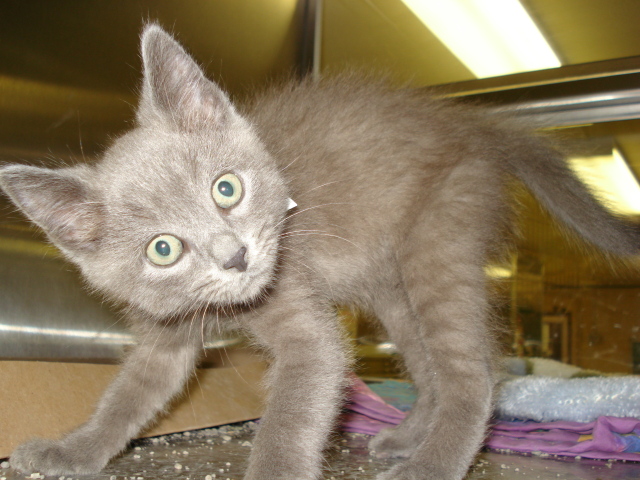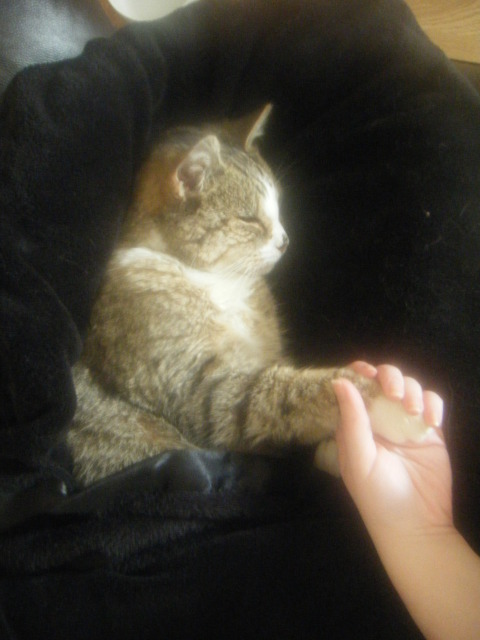Questionhello, i have a ten week old kitten and just have some general questions on taking car of him. the first day i got him from his foster mother she told me that he would keep me up all night w/ gorwling/meowing, and he did. it has been three days and he still does this for the entire night and for most of the day. he hides under my bed for most of the day, meowing. i have just moved him in the bathroom, i had to kind of trick him with one of his feather toys to get him to go into the bathroom :( i wanted to give him a smaller and quieter space. he does not let me touch him or pick him up. i do play with him with toys i've bought but he will never get that close to me and wont allow me to get close to him. when i do try and move slowly closer to him he hisses at me and runs. will this behavior continue? am i doing something wrong or does he just need time to adjust more.
AnswerAisha,
Congratulations! You are the new owner of a feral kitten!
I hope you have PLENTY of patience and time, because that is what it is going to take. Experienced people liken handling an angry feral kitten to wrestling with an animated cactus!
While kittens up to the age of 12 weeks can be tamed, older kittens often retain a degree of fearfulness and a small percentage of kittens (approx 10%) will not tame at all. On average, taming takes 2 - 6 weeks depending on a kitten's age and degree of wildness. Some come round within days, some take months and a few never come round at all.
The first step is to establish trust. This takes upwards of 2 weeks or more. At the beginning, keep the kitten in a large cage, pen, etc. in the middle of a room where they can see people frequently. But have a big towel or something fluffy to hide under. Ideally the cat should be at waist level where he feels less threatened by
your size. If the kitten is staying awake at night, try to play and socialize with them more during the day and cover their cage at night with a towel or blanket.
Spend plenty of time with them and talk gently to them. Always move slowly and quietly...they will be jumpy at first. When you're out of the room leave a radio or TV playing, preferably on a 'talking' channel, so they get used to human voices. For the first few days don't try to handle them. Keep offering tidbits and treats so they associate you as the food provider. Food is the key to their hearts. Once the cat has gotten used to having you fill the food bowl for it, try hanging out nearby while the cat eats. Sitting on your haunches is good, as the cat is more afraid of you when you are looming over it. Always talk to the cat in a friendly, encouraging voice while you are bringing its food or spending time with it while it eats.
Before opening the cage to change litter, food or water etc, ensure the room is escape proof. When you reach in to the pen, don't do so with outstretched fingers - curled fingers are less threatening. In feral kittens, caution overrides curiosity and they will defend themselves rather than investigate your fingers. When they are less frightened of you is the time to start playing through the cage with a feather or toy.
The kitten needs plenty of contact with people - not just physical contact, but just the presence of people nearby. If people walk past or sit around chatting but apparently ignoring the kittens, the kittens learn that humans aren't a threat to them. They also need to become accustomed to normal daily household sounds and activities if they are not to remain fearful of these in later life.
When the kitten has calmed down (after the first few days), let it loose in a small room for petting, playing, and 'training' sessions. Spend time sitting on the floor with some food that you yourself can eat. Drop the odd morsel close to you or offer it in your fingers - if you remain still and talk gently, the kitten should pluck up the courage to snatch the titbit. As it's confidence grows over several days, it will move closer in the hope of dropped titbits. Eventually it should overcome some of it's nervousness and start climbing on you in case you eat all of the food without accidentally dropping any!
You can now commence the stroking stage. Some tamers suggest placing a towel over it and if it stays calm, stroking it gently on the head from behind. Wrapping a frightened kitten in a towel while you pet it helps it to feel secure while getting used to being held and touched.If you approach from the front it may lash out in self-defense. Watch for body language signals and back off if the cat is growling, spitting or swishing tail. If it panics, stop stroking and talk reassuringly. When a feral kitten purrs while you stroke it, the battle is half-won!
Once it remains calm during stroking, you can work on picking it up. In the wild, once a kitten leaves its mother, the only thing likely to pick it up is a predator so it will either defend itself or freeze in fear. Grip it securely by the scruff, as its mother would, and place it on your lap. Hold it securely, stroking it and talking gently. Most will try to burrow their head under your arm, many will tremble, so you must be calm and reassuring.
If it starts to panic, put it "back home" (in its basket or the kitten-pen) and go back to the stroking stage when it calms down. Keep initial handling sessions brief before putting it "back home" (where it feels safe) and offering a tasty bribe. At first you won't be able to cup one hand under its hindquarters as it will kick out. Once it accepts being picked up without panicking, you can start supporting its bottom or using two hands as you would pick up a tame kitten.
When you pick up or hold the kitten do so securely but comfortably. Don't hold it too tight or squeeze it or it will associate handling with pain. Don't hold it so loosely that it can be dropped as this will only make it more frightened. To begin with you might need to use gloves.
If the kitten is unhandleable on your lap, try putting it in a top-opening wire cat carrier without any pad at the bottom. Place the cat carrier on your lap. When the kitten becomes settled in its 'safety cage' you can reach in and start stroking it or offering treats. Several sessions like this should accustom it to being on your lap and you can then dispense with the basket. If it falls asleep on your lap or wants a tummy rub - you've won!
Once the kitten doesn't object to being stroked and handled, invite other people - family and friends - to handle it, otherwise it might become a one-person cat.
Rehoming is traumatic for any cat and a tamed feral may revert back to wild for a while (from several days to several weeks) before bonding with its new owners. At first it will hide so you will need to go through similar steps above to a lesser degree, to gain its confidence.
I am including a link with a good article for you to read on getting a rehomed feral kitten. Copy and paste the whole link into your address bar, or type it:
http://www.forgottenfelines.com/new/pages/info/bringhome.html
If the kitten has already been handled/tamed then it is going to be a lot easier for you. The kitten will just need a brush-up course of the above steps of taming instead of the whole 'course'.
You and the kitten will do fine. Just remember patience, time, and very tasty treats (raw steak, tuna, etc.).
Carol

 Cant get cat to play
Question
Jules
My male cat Jules is 13. La
Cant get cat to play
Question
Jules
My male cat Jules is 13. La
 Cat and Dog Introductions
QuestionHi!
I recently acquired a tortie; although I wa
Cat and Dog Introductions
QuestionHi!
I recently acquired a tortie; although I wa
 Rehabilitating aggressive rescue cat!
QuestionA friend of me and my husbands was told a week
Rehabilitating aggressive rescue cat!
QuestionA friend of me and my husbands was told a week
 my old cat with no appetite
Question
Timmy since his loss o
Hi, Im really worried a
my old cat with no appetite
Question
Timmy since his loss o
Hi, Im really worried a
 My cat pees on the carpet!
Question
My Cat Tigger
Hi I have a male cat he i
My cat pees on the carpet!
Question
My Cat Tigger
Hi I have a male cat he i